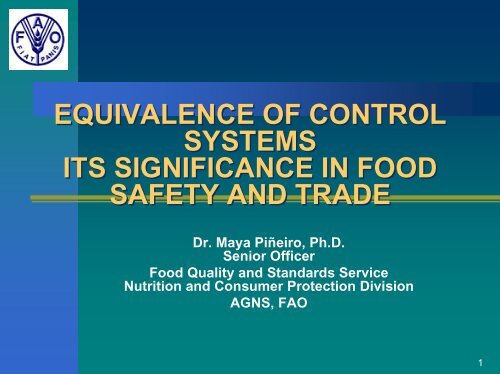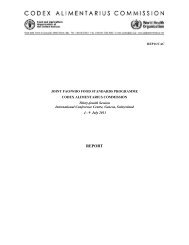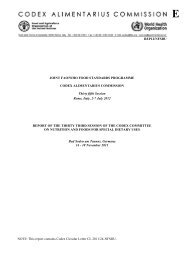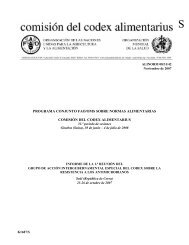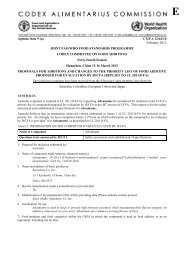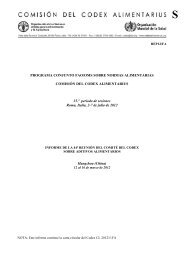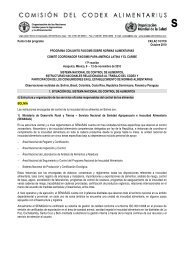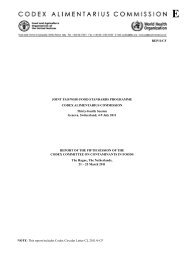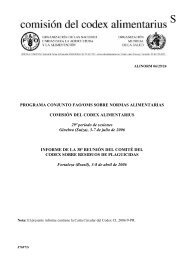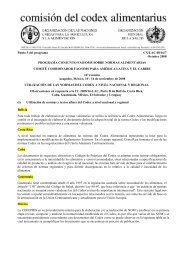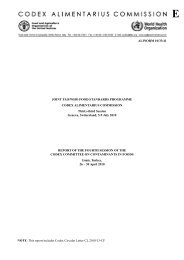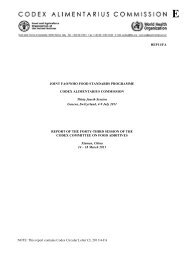equivalence - Cclac.org
equivalence - Cclac.org
equivalence - Cclac.org
Create successful ePaper yourself
Turn your PDF publications into a flip-book with our unique Google optimized e-Paper software.
EQUIVALENCE OF CONTROL<br />
SYSTEMS<br />
ITS SIGNIFICANCE IN FOOD<br />
SAFETY AND TRADE<br />
Dr. Maya Piñeiro, Ph.D.<br />
Senior Officer<br />
Food Quality and Standards Service<br />
Nutrition and Consumer Protection Division<br />
AGNS, FAO<br />
1
THE PROBLEM OF ANY<br />
MEASURE TO BE ADOPTED<br />
It should balance opposing requirements<br />
between:<br />
Regulatory autonomy at domestic level, and<br />
• Promoting social objectives (Health, Food<br />
Security)<br />
• Facilitating trade<br />
• Not hiding protectionist practices<br />
2
EQUIVALENCE<br />
Equivalence was last defined in 2004 for the SPS<br />
Agreement as:<br />
Mutual acceptance of another<br />
member’s standards which, although<br />
different, have the same effect.<br />
3
EQUIVALENCE AND MUTUAL<br />
RECOGNITION<br />
• Equivalence: recognizing that different<br />
control systems can reach the same<br />
objective: it normally refers to specific<br />
sanitary or phytosanitary measures.<br />
• Mutual Recognition: two trading<br />
countries recognize one another’s<br />
control procedures as valid: they may<br />
cover all foods or specific foods.<br />
4
EQUIVALENCE<br />
Equivalence is about obtaining the same<br />
results rather than to the methods used to<br />
do this: for example, accepting different<br />
measures that achieve the importing<br />
country’s appropriate level of protection.<br />
Equivalence is thus a different concept<br />
than mutual recognition, certification,<br />
conformity or harmonization.<br />
5
EQUIVALENCE<br />
‣ The SPS Agreement makes a general<br />
reference to <strong>equivalence</strong> for sanitary and<br />
phytosanitary measures.<br />
‣ The TBT Agreement assumes that the<br />
international standards it promotes are<br />
already equivalent, and so technical<br />
regulations and conformity assessment<br />
procedures should, if based on such<br />
international standards, be considered<br />
equivalent.<br />
6
EQUIVALENCE<br />
‣ The concept means recognizing that the<br />
same objective (the Appropriate Level of<br />
Protection - ALOP) can be reached with<br />
different measures.<br />
‣ Operationally, procedures should be set<br />
and adopted to confirm that the same<br />
objective is reached.<br />
‣ OBC (Objective Basis of Comparison)<br />
Tools to demonstrate ALOP <strong>equivalence</strong>.<br />
‣ Its scope needs to be extended to<br />
individual products or product groups.<br />
7
EQUIVALENCE IN THE SPS<br />
AGREEMENT<br />
The SPS Agreement makes explicit reference to<br />
<strong>equivalence</strong> in Article 4, Equivalence<br />
1. “Members shall accept the sanitary or phytosanitary<br />
measures of other Members as equivalent, even if these<br />
measures differ from their own or from those used by other<br />
Members trading in the same product, if the exporting<br />
Member objectively demonstrates to the importing Member<br />
that its measures achieve the importing Member's<br />
appropriate level of sanitary or phytosanitary protection.<br />
For this purpose, reasonable access shall be given, upon<br />
request, to the importing Member for inspection, testing<br />
and other relevant procedures<br />
2. Members shall, upon request, enter into consultations with<br />
the aim of achieving bilateral and multilateral agreements<br />
on recognition of the <strong>equivalence</strong> of specified sanitary or<br />
phytosanitary measures”<br />
8
EQUIVALENCE IN THE TBT<br />
AGREEMENT<br />
The TBT Agreement makes indirect reference to <strong>equivalence</strong>:<br />
‣ Art. 2.7 “Members shall give positive consideration to<br />
accepting as equivalent technical regulations of other<br />
Members, even if these regulations differ from their own,<br />
provided they are satisfied that these regulations<br />
adequately fulfil the objectives of their own regulations”.<br />
‣ Art. 6.1 “Without prejudice to the provisions of paragraphs<br />
3 and 4, Members shall ensure, whenever possible, that<br />
results of conformity assessment procedures in other<br />
Members are accepted, even when those procedures differ<br />
from their own, provided they are satisfied that those<br />
procedures offer an assurance of conformity with<br />
applicable technical regulations or standards equivalent to<br />
their own procedures. It is recognized that prior<br />
consultations may be necessary in order to arrive at a<br />
mutually satisfactory understanding regarding, in<br />
particular…”<br />
9
HOW IS EQUIVALENCE<br />
ACHIEVED<br />
‣ The SPS Agreement recommends “Members<br />
shall, upon request, enter into consultations with<br />
the aim of achieving bilateral and multilateral<br />
agreements on recognition of the <strong>equivalence</strong> of<br />
specified sanitary or phytosanitary measures.”<br />
(Art. 4.2)<br />
‣ The TBT Agreement states “Members are<br />
encouraged, at the request of other Members, to<br />
be willing to enter into negotiations for the<br />
conclusion of agreements for the mutual<br />
recognition of results of each other's conformity<br />
assessment procedures.” (Art. 6.3)<br />
10
HOW IS EQUIVALENCE<br />
ACHIEVED<br />
‣ The Agreements provide no specific<br />
guidance other than parties’ implicit<br />
willingness to facilitate trade.<br />
‣ For this reason, the Codex Alimentarius<br />
Commission has developed guidelines for<br />
the measures provided for in the SPS<br />
Agreement.<br />
‣ At the WTO, some members and<br />
multilateral <strong>org</strong>anizations have made<br />
suggestions and comments.<br />
11
ACHIEVIING EQUIVALENCE<br />
‣ Equivalence agreements (treaties, exchange of<br />
correspondence and memoranda of<br />
understanding) are necessary to facilitate trade,<br />
reducing costs for consumers.<br />
‣ There remain a large number of challenges<br />
associated with the judgement of <strong>equivalence</strong>.<br />
‣ There are relatively few operational agreements<br />
on recognition.<br />
‣ Work needs to be continued.<br />
12
DIFFICULTIES ENCOUNTERED IN<br />
ACHIEVING<br />
EQUIVALENCE<br />
“equality” instead of “<strong>equivalence</strong>”<br />
It is inappropriate to request the exporting<br />
country to demonstrate that its measure is<br />
equal to that of the importing country.<br />
Rather, it should demonstrate it is<br />
equivalent in order to achieve the required<br />
level of protection.<br />
13
DIFFICULTIES ENCOUNTERED IN<br />
ACHIEVING<br />
EQUIVALENCE<br />
Achieveing <strong>equivalence</strong> may require significant<br />
resources and lengthy negotiations with high<br />
administrative costs.<br />
‣ It is worth remembering that <strong>equivalence</strong> is a<br />
trade facilitation measure;<br />
‣ As such, it should be as cost-effective as<br />
possible;<br />
‣ Product lists need to be analyzed on a bilateral<br />
basis, taking into consideration associated risk<br />
levels and stressing the history, confirmed by<br />
historical records including rejections.<br />
14
DIFFICULTIES ENCOUNTERED IN<br />
ACHIEVING<br />
EQUIVALENCE<br />
The importing country should set its appropriate level of<br />
protection, and the exporting country should satisfactorily<br />
demonstrate that it can achieve it with its own measures<br />
This implies:<br />
‣ Very clear identification of the level of protection required<br />
by the importing country;<br />
‣ Explanation of the purpose of the measure and<br />
identification of the risk it intends to avoid;<br />
‣ Provision of scientific information supporting the<br />
recognition of <strong>equivalence</strong>;<br />
‣ Provision of technical assistance to help identify and<br />
implement measures recognized as equivalent.<br />
15
DIFFICULTIES ENCOUNTERED IN<br />
ACHIEVING<br />
EQUIVALENCE<br />
International guidance on <strong>equivalence</strong><br />
need to be available so that the<br />
principle may be applied consistently<br />
The CAC (CCFICS) has prepared<br />
guidelines, but active ongoing<br />
participation of Member Countries in the<br />
development of these texts is essential.<br />
16
EQUIVALENCE AND CODEX<br />
• The adopted “Principles for Food Import<br />
and Export Inspection and Certification”<br />
state:<br />
“Countries should recognize that different<br />
inspection/certification systems may be<br />
capable of meeting the same objective,<br />
and are therefore equivalent. The<br />
obligation to demonstrate <strong>equivalence</strong><br />
rests with the exporting country.”<br />
17
EQUIVALENCE AND CODEX<br />
• The “Guidelines for the Design, Operation,<br />
Assessment and Accreditation of Food Import and<br />
Export Inspection and Certification Systems” state:<br />
“The recognition of <strong>equivalence</strong> of inspection and<br />
certification should be facilitated where it can be<br />
objectively demonstrated that there is an<br />
appropriate system for inspection and certification<br />
of food by the exporting country in accordance with<br />
these guidelines.”<br />
18
EQUIVALENCE AND CODEX<br />
• The “Guidelines for the Development of<br />
Equivalence Agreements…”<br />
• Guidelines on the Judgement of Equivalence of<br />
Sanitary Measures Associated with Food<br />
Inspection and Certification Systems (2003)<br />
• Appendices being prepared<br />
19
EQUIVALENCE AND CODEX<br />
The guidelines also state that :<br />
• The same food produced in different places<br />
may result in different hazards;<br />
• Control methodologies may be different but<br />
they should produce the same results;<br />
• Imported and domestic food control should<br />
be designed to ensure the same level or<br />
protection;<br />
• Unnecessary control duplication should be<br />
avoided.<br />
20
DIFFICULTIES ENCOUNTERED IN<br />
ACHIEVING<br />
EQUIVALENCE<br />
Transparency in <strong>equivalence</strong><br />
agreements and confidence in the<br />
<strong>equivalence</strong> judgment process is<br />
needed<br />
Contact Points could provide information<br />
on concluded agreements as well as the<br />
terms and criteria adopted.<br />
21
SOME REQUIREMENTS TO REACH<br />
EQUIVALENCE AGREEMENTS<br />
‣ The (legal and regulatory) infrastructure, specific<br />
requirements (facilities, equipment, processes,<br />
procedures and tests ), scope and required levels<br />
of protection need to be available.<br />
‣ Difficulties may be encountered during<br />
negotiations and eventually hinder progress at<br />
some stage, particularly when analyzing facilities;<br />
assessing laboratories and systems for efficient,<br />
qualified inspection; and performing audits and<br />
early warning systems.<br />
22
CONSIDERATIONS<br />
‣ Reaching a balance between a more structured<br />
approach and another providing more flexible<br />
options also facilitating trade: exchange of<br />
correspondence or MOU,<br />
‣ Defining the scope (including individual products<br />
or sectors),<br />
‣ Clearly defining the involved parties,<br />
‣ Bearing in mind the history,<br />
‣ Access is not necessarily limited, for some<br />
countries, to <strong>equivalence</strong> agreements, except for<br />
sensitive sectors (meat and poultry).<br />
23
BENEFITS OF AGREEMENTS ON<br />
MUTUAL RECOGNITION<br />
• Assuring consumers of an appropriate level<br />
of protection,<br />
• Better joint use of resources,<br />
• Trade facilitation and elimination of delays at<br />
ports of entry,<br />
• Less dependence on routine inspections<br />
• Harmonization of food regulations and<br />
control systems,<br />
• Quick solutions to problems<br />
24
CONCLUSION<br />
• Agreements on mutual recognition and<br />
<strong>equivalence</strong> have the potential to<br />
facilitate trade and reduce costs<br />
• A number of challenges associated with<br />
how to judge <strong>equivalence</strong><br />
• CCFICS actively works on the<br />
development of guidelines on these<br />
matters<br />
25


